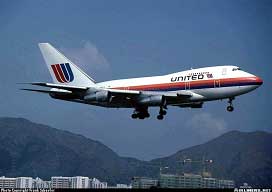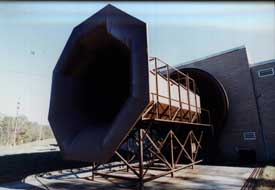Fuel Tank Protection Facilities
The following is a brief description of some of the FAA's Fire Safety Section's facilities that are used for work in the area of fuel tank protection. For more information on the Fire Safety Section's facilities, click here.
747SP Ground-Test Article

The Boeing 747SP was decommissioned from service with United Airlines and acquired by the FAA. It is being employed as an aircraft test article to develop and test GBI systems, and to characterize the fuel vapor flammability in a heated center wing tank. This test article is schedule to be used to support other aircraft safety R&D efforts in the area of aging systems. All aircraft systems are in tact and operational, including the complete fuel system, all engines, and the APU. The test article is presently located in the wash rack area of the Wm. J. Hughes Technical Center aircraft ramp.
The aircraft has 4 main wing fuel tanks, 4 wing tip reserve fuel tanks, and a large center wing fuel tank (CWT). The CWT is approximately 242 inches long and 255 inches wide with height varying from 78 inches to 48 inches. It has 6 bays, 2 of which are the full width of the fuselage, and 4 of which are two full-length bays dissected mid-way with a partial rib. A large dry bay exists forward of the 2 full width fuel bays, but aft of the forward spar. The CWT is vented to the wing tip surge tanks via a vent channel in the wings with venting tubing contained with the tank. The vent channels run most the length of the wing and terminate in the surge tank, which vents at the underside of the wing. Three air cycle machines exist immediately below the CWT.
Presently, the CWT is instrumented with ullage, fuel, and surface mounted thermocouples as well as sample gas tubing and pressure taps. The gas sampling system has the capability of measuring both oxygen concentration and total hydrocarbon concentration (THC) at eight locations in the tank.
Pressure Fire Modeling Facility

This facility houses a 10 m3 pressure vessel with a working pressure of 650 psi at 750°F that has been used in recent years for testing involving explosive mixtures (e.g., aerosol cans, fuel vapors). An attached vacuum pump allows for evacuation of the vessel to pressures such as would be seen at altitude. Currently, this facility is used for ignition experiments with JP-8 fuel vapors existing at various fuel-air ratios, altitudes and oxygen concentrations.
Environmental Chamber

The environmental test chamber is designed to simulate preset temperature, humidity, and air pressure (altitude) conditions. Chamber controllers can be programmed to simulate an entire flight from takeoff to climb-out, cruise, approach, and landing. The test chamber measures 72 x 71 x 93 inches. The environmental chamber has been used to study the behavior of in-flight fires at altitude, to evaluate the performance of wing ice detectors, and to calibrate various environmental sensors. Currently, a 17 ft3 fuel tank resides inside of the chamber for use in a variety of fuel flammability and fuel tank inerting experiments.
Airflow Induction Test Facility

The airflow induction facility is a wind tunnel with a 5 ½ foot diameter high speed test section which can generate commercial transport airplane flight speeds at a reduced static pressure. The wind tunnel also has a low speed front test section which has a 9 foot octagon cross section that can generate wind speeds of 120 miles per hour. The wind tunnel is a unique induction type which is non-return. It is operated by exhausting the flow from two jet engines into the diffuser section of the wind tunnel. This primary flow generates a secondary flow into the wind tunnel nozzle and through the test section. It can be used to study a variety of issues associated with the flight of an aircraft.
The Airflow Induction Test Facility is presently being utilized to study composite and aluminum wing tank flammability.
For information contact:
Steve Summer
Phone: (609) 485-4138
Fax: (609) 485-5785
 Federal Aviation Administration
Federal Aviation Administration